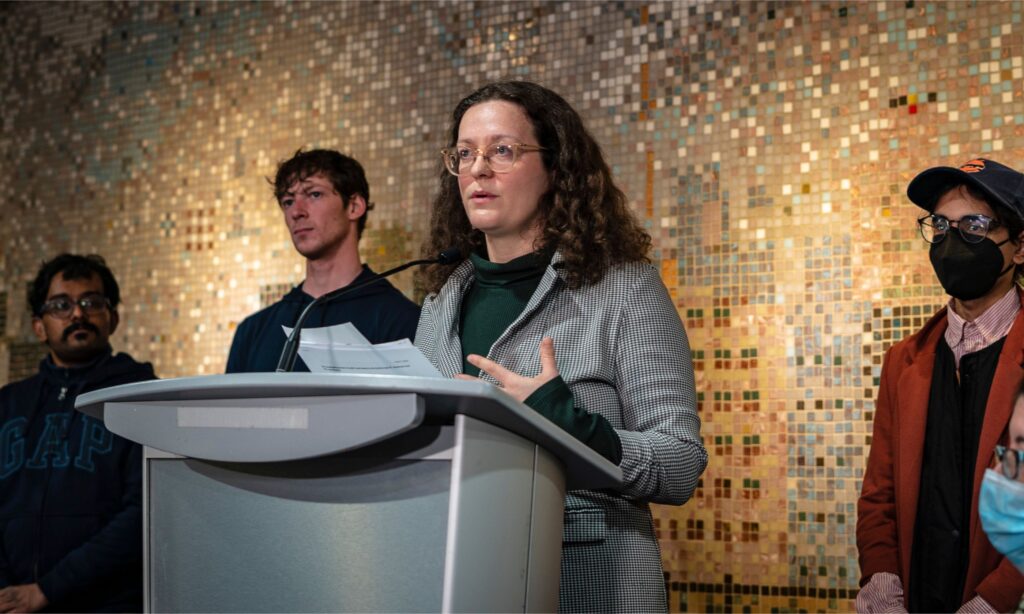
Shelagh Pizey-Allen, the leader of TTC Riders, talks about the campaigns she’s helped win since becoming executive director of the transit-advocacy organization in 2018. The list is long and impressive. (Photo: Shelagh Pizey-Allen)
Shelagh Pizey-Allen, the leader of TTC Riders, tells me about the campaigns she’s helped win since becoming executive director of the transit-advocacy organization in 2018. The list is long.
The group convinced city council to establish a reduced-rate transit pass for low-income residents, successfully lobbied to make the King Street Transit Priority Corridor permanent, and, most recently, helped land the Scarborough busway — a protected bus-only lane that will follow the route of the decommissioned RT.
Pizey-Allen also pushed for a permanent federal transit fund that will support subway, bus, and light-rail expansion and for a levy on Toronto’s commercial parking lots (set to be debated at council later this year) that would generate revenue for transit improvements.
But she’s hesitant to take credit and, in fact, challenges the whole notion that political progress is the result of one leader’s actions. “It’s not really about me,” she says. “It’s about TTC Riders.”
Pizey-Allen grew up in Winnipeg and found her voice as an activist early. At age 14, she saw a queer friend being bullied and spoke out. “I wanted to do something to show that he wasn’t alone and that there were serious consequences to homophobia,” she recalls. “We had this speech contest in our school, and I wrote a speech … educating people about how deadly and violent homophobia can be.”
While studying at the University of Winnipeg, she volunteered at a community radio station and travelled to Grassy Narrows First Nation in northern Ontario to make a documentary. She connected with activists who were protesting destructive forestry practices. It was a key moment in her political education. “I got to meet some of the young people who had started Canada’s longest-running logging blockade back in 2002 and [saw] their bravery. They were out there in the … dead of winter, blocking a logging road, and that really inspired me.”
TTC Riders strives to make activism fun. “One of my favourite actions was when volunteers painted a pop-up bus lane on Dufferin [Street] to just show how fast and easy it could be to install more transit priority lanes. More recently, we held an awards ceremony for Toronto’s slowest bus route.”
In 2014, Pizey-Allen moved to Toronto to do a master’s in communications studies. She became a teaching assistant, joined the Canadian Union of Public Employees, and soon found herself on strike. That, too, proved to be part of her activist training. “I made some really good friends because we were walking the picket line every day,” she says. “And [I learned] the importance of collective action.”
In building TTC Riders, Pizey-Allen has focused on understanding what motivates people to volunteer their time. She wants them to gain a sense of empowerment and feel part of a community. “I think people get involved not just because they want to make a difference. They also want to get something out of the experience, whether it’s a new skill or just connecting with people in their neighbourhood.”
TTC Riders strives to make activism fun. “One of my favourite actions was when volunteers painted a pop-up bus lane on Dufferin [Street] to just show how fast and easy it could be to install more transit priority lanes. More recently, we held an awards ceremony for Toronto’s slowest bus route.”
Pizey-Allen also created a members’ book club. “We were trying to find ways to involve new people but also connect with each other and learn.”
She uses her campaigns to develop leadership, especially among youth. And she wants nascent leaders to support not only her own organization but also social movements more broadly. She’s delighted, for example, to see young activists take TTC Riders’ training sessions on public speaking or media relations, then deploy their new knowledge with other groups. “The most rewarding thing about our work is when someone becomes involved in collective action for the very first time through TTC Riders and then goes on to bring their skills to another campaign or start a different organization based on what they’ve learned through us.”
“After I’d lived here for a while, I saw how unequal access to public transit is. I was really amazed at the subway system and then quickly learned that it’s not available to all neighbourhoods.”
TTC Riders’ commitment to social equity stems, in part, from Pizey-Allen’s own experience. “After I’d lived here for a while, I saw how unequal access to public transit is. I was really amazed at the subway system and then quickly learned that it’s not available to all neighbourhoods.”
The group campaigns not only in middle-class enclaves like the Annex but also in working-class inner suburbs, like portions of Scarborough. “We want to prioritize improving transit where it’s needed most and where those improvements are going to help people with disabilities and racialized and lower-income transit users,” Pizey-Allen explains. Hence the campaign to win a high-quality Scarborough busway — crucial infrastructure in a part of the city where transportation options are traditionally substandard.
There’s also a justice component in the group’s embrace of the commercial parking levy, a fee that would raise up to $150 million annually from the owners of big shopping malls rather than from mom-and-pop shops.
As we conclude our conversation, I ask Pizey-Allen what she hopes to see in the coming months. She says she’d like the feds’ permanent transit fund, currently set to launch in 2026, to open this year. And she wants the fund to both create new transit lines and improve those already running.
“The permanent transit fund … is great news,” she says. “But we’d like to see it sped up and be more flexible so cities like Toronto could use it to run more frequent service and entice people on to the TTC by making it more frequent, more affordable, more reliable.”
This article was originally published as in TVO today.
Ask Ontario for more transit funding!
Related projects
Always grounded in sound evidence, the David Suzuki Foundation empowers people to take action in their communities on the environmental challenges we collectively face.



